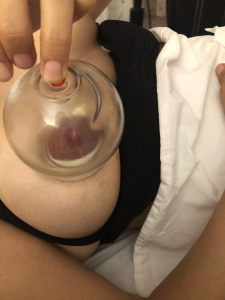A case study in effective pain relief for breastfeeding new mothers
By Deb Davies, DACM, LAc
Reprinted with permission from Acupuncture Today.
This article examines the treatment of a 42-year-old mother presenting with a chief complaint of clogged and painful milk ducts from breastfeeding with Chinese medicine, specifically using cupping. It demonstrates the simplicity and effectiveness of this modality. Why aren’t more acupuncturists using this method while also suggesting the answer? It isn’t taught. The specific methods used on one patient to alleviate the discomfort that brought her to seek treatment are discussed while emphasizing the ease and effectiveness of using this procedure. The results prove that while cupping is underused, it can be an effective method for treating clogged milk ducts and mastitis. A better dissemination throughout the Chinese medical community of the results breast cupping can provide, and the methods to perform the technique, would enable more acupuncturists to help new mothers have a better breastfeeding experience.
Case Presentation and Diagnosis
A 42-year-old female, 33 days postpartum, presented with a white spot, or plugged milk duct, on her right nipple. It hurt for her baby to latch on to her breast to feed and after breastfeeding. She was breastfeeding every 2 to 3 hours around the clock and experiencing constant burning pain in her left nipple. A white bleb (small blister) was visible on the tip of the patient’s right nipple, one half inch in size, with her left nipple appearing darker than the right. Upon examination, both breasts were swollen and warm to touch. The patient noted they had been larger and warmer in the past two days than they had been since she gave birth. The patient believed her baby may have a tongue and/or lip tie but was resistant to the surgery necessary to correct it, due to the discomfort it could cause her baby.
I diagnosed her with heat and toxic-heat affecting the liver, stomach, and gallbladder channels leading to accumulation of pus with an underlying spleen qi deficiency, liver blood deficiency, and both liver and kidney yin deficiency.
Treatment Strategy and Application
To treat, I cupped both breasts with glass cups, using the subsequent acupuncture prescription to clear toxic-heat, move stagnant qi in her liver and stomach channels, and tonify her spleen and kidneys. The points Spleen 4 and Pericardium 6 were used to open the chong channel, Large Intestine 11 to clear heat, Ren 6 to tonify kidney, Ren 12 to tonify spleen and stomach, Small Intestine 1 to promote lactation and benefit the breast, and Stomach 43 to clear heat from the stomach channel.
The patient lay supine and opened both sides of her nursing bra (this does require a level of trust and comfort in the patient) then self-applied organic coconut oil on her breasts followed by several drops of lavender essential oil. A warm, large glass fire cup with 90-proof rubbing alcohol to light the cotton was used, with the treatment room kept warm. I warmed the cup with the fire before applying it to her skin, checking the temperature with my hand to make sure it was neither too hot nor too cold for her breast. This is very important to ensure the patient is comfortable and won’t be caused further discomfort from incorrect cup temperature! I then placed a warm cup directly over each of her nipples and left them stationary. There was a heat lamp warming her lower abdomen as I did the cupping and the rest of her remained covered with blankets.
Immediate Results and Follow-Up Care
She experienced near instant relief! The bleb burst, milk exploded into the glass cup, and the patient’s pain immediately decreased. Milk continued slowly seeping out of her nipple, so I showed the patient how to break suction when she was ready, and she removed the cup after two minutes.
Two hours after my patient left my office, she sent me a text saying she just did a Rodin soak (warm Epsom saltwater soak, dipping her breasts into a large bowl for two minutes) after feeding. Attached was a picture of discharge that was preventing her milk from flowing and contributing to her pain. She expressed her tremendous feeling of relief since she was cupped, and then again when this accumulation of discharge came out.
Are you interested in becoming a certified acupuncture professional?
Visit the links below to explore our specialized acupuncture programs at a campus near you:
Broader Implications for Breastfeeding Support
My experience from attending hundreds of births as a birth doula, and supporting these same women postpartum, led to the concept of cupping for mastitis relief. I educated myself with the help of many postpartum women with clogged milk ducts who trusted me to help them feel better. Every single time I have used this technique, it has quickly yielded remarkable results.
Not many acupuncturists are cupping breasts, despite it being easy and effective. This drives me to shed light on this technique and the topic of supporting new mothers to the full capability of Chinese medicine through an easy-to-learn technique. Beyond ensuring the comfort level of the patient during treatment, you are simply clearing heat while moving stuck qi and blood.
This type of treatment can be applied to the thousands of women in the U.S. who attempt to breastfeed their children and end up in pain. Mastitis can become so uncomfortable that many women have stopped breastfeeding due to the pain and lack of an effective, lasting treatment. If we can help these breastfeeding mothers have freely-flowing breasts, they could potentially breastfeed longer—an option which is wonderful for mother-child bonding as well as for building healthy immunity for the child—yet so many women are forced to choose otherwise from the pain of mastitis.
In the end, she did decide to take her baby for a laser tongue tie procedure to fix his tight jaw. As soon as the procedure was complete, both mother and child began much better breastfeeding sessions, where she experienced little to no pain. The baby is now getting plenty of milk, gaining weight, and is less fussy overall. The patient came in once more 3 weeks later, and we repeated the same treatment to clear out any residual accumulations. Since I have not heard from her again, the conclusion is that the combined treatment of mother and child was effective in relieving any breastfeeding pain.
Conclusion and Call for Wider Adoption
While this is one case study that proved to be especially responsive to breast cupping for mastitis, through my experience in my pre/postnatal specialty practice, it is not an abnormal result. Fire cupping has been an uncomplicated and effective modality for many women who have come into my practice and allowed me to treat them. By sharing this method, I hope to encourage other acupuncturists to turn to cupping when they encounter the same complaints from new mothers.
References
American Psychological Association. (2010). Publication manual of the American psychological association (6th ed.). Washington, DC: American Psychological Association.
Betts, D. (2006). The essential guide to acupuncture in pregnancy & childbirth. East Sussex, England: Journal of Chinese Medicine.
Flaws, B. (1993). Path of pregnancy: A handbook of traditional Chinese postpartum diseases (Vol. II). Boulder, CO: Blue Poppy Press.
Maciocia, G. (2005). Obstetrics & gynecology in Chinese medicine. China: Elsevier Ltd.
West, Z. (2001). Acupuncture in pregnancy & childbirth. China: Elsevier Ltd.
Featured Posts:
- A TCM Approach to Nourishing The New Mother: Acupuncture & Dietary Therapy for Postpartum Healing
- Ancillary Services for Enhancing Cosmetic Facial Acupuncture Outcomes and Increasing Business Revenue
- National Breast Cancer Awareness Month
- The Many Benefits of Chinese Cupping
- October is Breast Health Awareness Month: Are You Aware of What You Can Do for Your Health?

